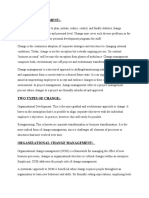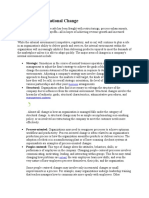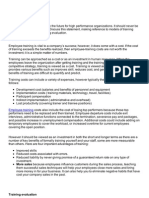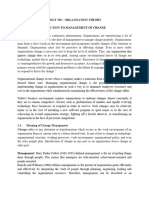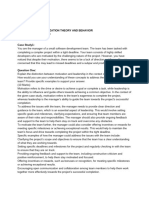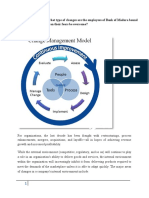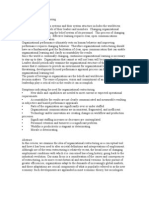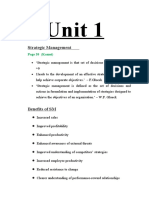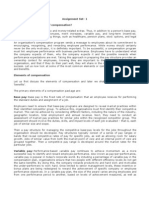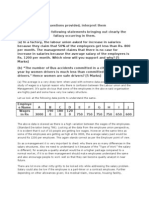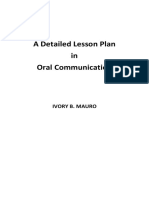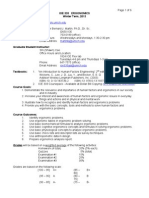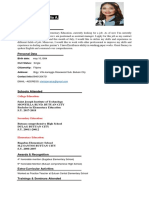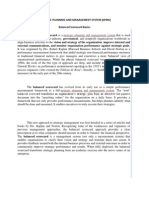MU0018 - Sem 4 - Fall 2011
MU0018 - Sem 4 - Fall 2011
Uploaded by
Ashraf HussainCopyright:
Available Formats
MU0018 - Sem 4 - Fall 2011
MU0018 - Sem 4 - Fall 2011
Uploaded by
Ashraf HussainOriginal Title
Copyright
Available Formats
Share this document
Did you find this document useful?
Is this content inappropriate?
Copyright:
Available Formats
MU0018 - Sem 4 - Fall 2011
MU0018 - Sem 4 - Fall 2011
Uploaded by
Ashraf HussainCopyright:
Available Formats
August 2011
Master of Business Administration-MBA Semester IV Subject Code MU0018 Subject Name Change Management 4Credits (Book ID: B1339) Assignment Set- 1 (60 Marks)
Note: Each question carries 10 Marks. Answer all the questions.
1. What are the types of organizational change?
Ans : Organizational change occurs when an organization restructures resources to increase the
ability to create value and improve effectiveness. A declining company seeks ways o regain customers; a growing organization designs new products. Change is prevalent. In the past 10 years, over 50 percent of all Fortune 500 companies have undergone significant restructuring. While the external environment (competitive, regulatory, and so on) will continue to play a role in an organization's ability to deliver goods and services, the internal environment within the organization will increasingly inhibit it from delivering products required to meet the demands of the marketplace unless it is able to adapt quickly. The major areas of changes in a company's internal environment include: Strategic: Sometimes in the course of normal business operation it is necessary for management to adjust the firm's strategy to achieve the goals of the company, or even to change the mission statement of the organization in response to demands of the external environments. Adjusting a company's strategy may involve changing its fundamental approach to doing business: the markets it will target, the kinds of products it will sell, how they will be sold, its overall strategic orientation, the level of global activity, and its various partnerships and other joint-business arrangements. Structural: Organizations often find it necessary to redesign the structure of the company due to influences from the external environment. Structural changes involve the hierarchy of authority, goals, structural characteristics, administrative procedures, and management systems. Almost all change in how an organization is managed falls under the category of structural change. A structural change may be as simple as implementing a no-smoking policy, or as involved as restructuring the company to meet the customer needs more effectively. Process-oriented: Organizations may need to reengineer processes to achieve optimum workflow and productivity. Process-oriented change is often related to an organization's
August 2011
production process or how the organization assembles products or delivers services. The adoption of robotics in a manufacturing plant or of laser-scanning checkout systems at supermarkets are examples of process-oriented changes. People-centered: This type of change alters the attitudes, behaviors, skills, or performance of employees in the company. Changing people-centered processes involves communicating, motivating, leading, and interacting within groups. This focus may entail changing how problems are solved, the way employees learn new skills, and even the very nature of how employees perceive themselves, their jobs, and the organization. Some people-centered changes may involve only incremental changes or small improvements in a process. For example, many organizations undergo leadership training that teaches managers how to communicate more openly with employees. Other programs may concentrate on team processes by teaching both managers and employees to work together more effectively to solve problems. Remember that strategic, structural, process-oriented, and people-centered changes occur continuously in dynamic businesses. Often, changes in one of these areas impact changes in the other areas. Many employees believe that a change is often reactive and nothing more than a quick fix; then they brace themselves for more changes in the future. Management needs to realize that serious underlying problems in organizations must be addressed with long-term consequences in mind. Thus, when management implements changes, careful thought must be given to ensure that the new processes are for the long-term good of the company.
2. Explain change management process? Ans : 3. Discuss the factors responsible for resistance. 4. Explain challenges in implementing the successful change. 5. Write a note on transformation strategies. 6. Differentiate between effectiveness and efficiency.
August 2011
Subject Code MU0018 Subject Name Change Management Assignment Set- 2 (60 Marks)
Note: Each question carries 10 Marks. Answer all the questions.
Q.1 Q.2 Q.3 Q.4 Q.5 Q.6 Explain Organizational structure. Discuss the reasons for Business change Explain Lewins model of change. Write a note on leadership framework. Write a note on learning culture. Explain the open system approach to change management.
You might also like
- HighscopeDocument9 pagesHighscopeapi-352557502No ratings yet
- Change Management TheoriesDocument114 pagesChange Management TheoriesEdison B. BuenconsejoNo ratings yet
- Chapter 18 - Transformational ChangeDocument6 pagesChapter 18 - Transformational ChangeAzael May PenaroyoNo ratings yet
- Semi DetailedDocument2 pagesSemi DetailedIda Tiks100% (2)
- Change ManagementDocument17 pagesChange ManagementMeenakshi Bisht Rawat100% (2)
- Module 1. Concept of Strategic Management (Strategic Management and Total Quality Management) - Rmec 412Document7 pagesModule 1. Concept of Strategic Management (Strategic Management and Total Quality Management) - Rmec 412Maritoni Medalla100% (1)
- Change ManagementDocument9 pagesChange ManagementManish SinghNo ratings yet
- Summer 2015 White House Interns ListDocument4 pagesSummer 2015 White House Interns ListPhil AmmannNo ratings yet
- Types of Organizational Change: BusinessDocument2 pagesTypes of Organizational Change: BusinessPramod Shet100% (1)
- Change ManagementDocument12 pagesChange Managementrevdambogo100% (1)
- MS 25Document6 pagesMS 25Rajni KumariNo ratings yet
- Understanding The Meaning of Change ManagementDocument2 pagesUnderstanding The Meaning of Change ManagementNangoli SudiNo ratings yet
- Change ManagementDocument2 pagesChange ManagementNangoli SudiNo ratings yet
- 5 Types of Organizational ChangeDocument9 pages5 Types of Organizational ChangekookyinNo ratings yet
- Organisational Change and Stress ManagementDocument18 pagesOrganisational Change and Stress ManagementDisha GanatraNo ratings yet
- OCD Unit 2Document16 pagesOCD Unit 2vedant.kanu03No ratings yet
- Types of Environmental Change & Factors Affecting Environmental ChangeDocument6 pagesTypes of Environmental Change & Factors Affecting Environmental ChangeNene TapsNo ratings yet
- Managing Organizational Change Student Name Course Professor Name Date of SubmissionDocument10 pagesManaging Organizational Change Student Name Course Professor Name Date of SubmissionjoelNo ratings yet
- Data Q 3Document7 pagesData Q 3Jeffrey ThomasNo ratings yet
- FC 407-Human Behavior in The Organization: Types of Environmental ChangeDocument6 pagesFC 407-Human Behavior in The Organization: Types of Environmental ChangeNene TapsNo ratings yet
- Answer of Some HRM ActivitiesDocument6 pagesAnswer of Some HRM ActivitiesAl AminNo ratings yet
- Organisational BehaviourDocument12 pagesOrganisational Behaviourabhi malikNo ratings yet
- Leadership and Change Management Chapter 4Document17 pagesLeadership and Change Management Chapter 4sabit hussenNo ratings yet
- BMGT 300 - Topic Nine Management of Change - 221012 - 161249Document17 pagesBMGT 300 - Topic Nine Management of Change - 221012 - 161249Pa HabbakukNo ratings yet
- 603 - Organisational Change and DevelopmentDocument11 pages603 - Organisational Change and DevelopmentlocalsingerytNo ratings yet
- ELE ELO - Final PaperDocument8 pagesELE ELO - Final Papertimchuareyes0203No ratings yet
- CH 16Document21 pagesCH 16Teddy MetaNo ratings yet
- Managing Organizational ChangeDocument7 pagesManaging Organizational Changebabypharsa27No ratings yet
- Untitled DocumentDocument3 pagesUntitled DocumentMusa GorodNo ratings yet
- Chapter 11 - Organizational Change and DevelopmentDocument7 pagesChapter 11 - Organizational Change and DevelopmentThisisfor TiktokNo ratings yet
- Definition: Organisational Change Is The Process by Which Organisations Move From Their PresentDocument6 pagesDefinition: Organisational Change Is The Process by Which Organisations Move From Their PresentMonica KhareNo ratings yet
- Critical Analysis of Models OF Organizational Development: (For Internal Assessment)Document25 pagesCritical Analysis of Models OF Organizational Development: (For Internal Assessment)All in SylvesterNo ratings yet
- Chapter 10 Change ManagementDocument10 pagesChapter 10 Change ManagementPrincess Czarina Delas AlasNo ratings yet
- 7ChangeManagement_382f94aff0764ee582076ca6113cc924Document28 pages7ChangeManagement_382f94aff0764ee582076ca6113cc924Salman KhanNo ratings yet
- Change Management: Muhammad HashimDocument11 pagesChange Management: Muhammad HashimMalkeet SinghNo ratings yet
- Organizational Change FileDocument3 pagesOrganizational Change Filepoojanayak3111No ratings yet
- Assisnment Cuting EdgeDocument20 pagesAssisnment Cuting EdgeIngva AjithNo ratings yet
- Module 1Document28 pagesModule 1Anand HIREMATHNo ratings yet
- Organizational RestructuringDocument6 pagesOrganizational Restructuringnicks_rose02100% (2)
- Compilation in ODDocument28 pagesCompilation in ODAbe riveraNo ratings yet
- Course 1. Organizational Change Management. MSDA IIDocument4 pagesCourse 1. Organizational Change Management. MSDA IIAlin ApostolescuNo ratings yet
- ODDocument18 pagesODMeenakshi GodaraNo ratings yet
- Unit 1: Strategic ManagementDocument67 pagesUnit 1: Strategic ManagementPragya ChakshooNo ratings yet
- Strategic Change Process: SyllabusDocument32 pagesStrategic Change Process: Syllabussamreen workNo ratings yet
- Change Management 2010Document5 pagesChange Management 2010Mrinal MehtaNo ratings yet
- What Is Strategic ManagementDocument9 pagesWhat Is Strategic Managementsamridhi chhabraNo ratings yet
- Change ManagementDocument52 pagesChange ManagementSuneeth VergheseNo ratings yet
- Change ManagementDocument22 pagesChange ManagementSimit KhajanchiNo ratings yet
- Strategic Management and Total Quality ManagementDocument7 pagesStrategic Management and Total Quality ManagementstephaniegipanNo ratings yet
- Organiztional Behavior CH 8Document21 pagesOrganiztional Behavior CH 8Yeabsera DemelashNo ratings yet
- ChangeDocument21 pagesChangeasterbilodassekoo1433No ratings yet
- Management of Change NotesDocument29 pagesManagement of Change Notes4mx9t6tcz9No ratings yet
- Business Management and ChangeDocument4 pagesBusiness Management and ChangeJodyNo ratings yet
- 7s FrameworkDocument3 pages7s FrameworkmirronaiNo ratings yet
- Eniola Chapter 1-3Document7 pagesEniola Chapter 1-3ADAMNo ratings yet
- Transformation Course WorkDocument4 pagesTransformation Course Workkibalamarogers862No ratings yet
- Change Management: Individuals Teams OrganizationsDocument3 pagesChange Management: Individuals Teams OrganizationsVarun VaishnavNo ratings yet
- Assignment SubmissionDocument13 pagesAssignment SubmissionPramod GowdaNo ratings yet
- Performance Measurement - Presentatie Met MarieDocument4 pagesPerformance Measurement - Presentatie Met MarieMaria KolberNo ratings yet
- 5 Steps in the Change Management Process _ HBS OnlineDocument6 pages5 Steps in the Change Management Process _ HBS Onlinejaimon123No ratings yet
- Ulc A2Document22 pagesUlc A2Nguyễn Minh NgọcNo ratings yet
- Organizational ChangeDocument24 pagesOrganizational ChangePrajna DeyNo ratings yet
- The Power of Habit Stacking: Change Management and Organizational ChangeFrom EverandThe Power of Habit Stacking: Change Management and Organizational ChangeNo ratings yet
- MB0053 - International Business Management - Sem 4 - Fall 2011Document16 pagesMB0053 - International Business Management - Sem 4 - Fall 2011Ashraf HussainNo ratings yet
- Q.1 What Are The Types of Organizational Change? Ans:-: Assignment Set-1Document21 pagesQ.1 What Are The Types of Organizational Change? Ans:-: Assignment Set-1Ashraf HussainNo ratings yet
- Q.1 Write A Note On Scope of Talent Management? Ans:: Assignment Set-1Document15 pagesQ.1 Write A Note On Scope of Talent Management? Ans:: Assignment Set-1Ashraf HussainNo ratings yet
- Mu0015 - Set 1 & 2Document13 pagesMu0015 - Set 1 & 2ravinderkumarchowdhuryNo ratings yet
- Mu-0016 Set 1 & sET 2Document22 pagesMu-0016 Set 1 & sET 2ravinderkumarchowdhury100% (1)
- BB0007 Management Information SystemsDocument29 pagesBB0007 Management Information SystemsAshraf HussainNo ratings yet
- BB0010 Quantitative Techniques in Business 2Document18 pagesBB0010 Quantitative Techniques in Business 2Ashraf HussainNo ratings yet
- A Study On Job SatisfactionDocument87 pagesA Study On Job SatisfactionAshraf HussainNo ratings yet
- BB0009 Fall Drive Assignment 2011Document2 pagesBB0009 Fall Drive Assignment 2011Ashraf HussainNo ratings yet
- University College of Engineering: Rajasthan Technical University, KotaDocument4 pagesUniversity College of Engineering: Rajasthan Technical University, KotaPankaj AgarwalNo ratings yet
- Solidworks Tutorial 11: Certified Solidworks Associate (Cswa)Document40 pagesSolidworks Tutorial 11: Certified Solidworks Associate (Cswa)JoseEliasNo ratings yet
- 6DS BFA A19 CombineDocument3 pages6DS BFA A19 CombineAdnan GeeNo ratings yet
- Letter To Regents From CU AlumniDocument19 pagesLetter To Regents From CU Alumnimary winterNo ratings yet
- Career Development in The Gaming IndustryDocument4 pagesCareer Development in The Gaming IndustryTinaMerryNo ratings yet
- Career Executive Service Written Exam CESWE ReviewDocument4 pagesCareer Executive Service Written Exam CESWE ReviewRhyan Bunao PillogoNo ratings yet
- Farrow - Mtle Results WebDocument6 pagesFarrow - Mtle Results Webapi-344845620No ratings yet
- Financial Literacy and Life CycleDocument5 pagesFinancial Literacy and Life CyclejyotsfunmakerNo ratings yet
- Av Aids FinalDocument17 pagesAv Aids Finalprecillathoppil0% (1)
- De Cuong Anh 9 HK2-2023 - NaninhDocument14 pagesDe Cuong Anh 9 HK2-2023 - NaninhQuynh Anh VoPhuongNo ratings yet
- Sentence & Non-SDocument6 pagesSentence & Non-SPrincess De VegaNo ratings yet
- Group PresentationDocument11 pagesGroup Presentationapi-697299769No ratings yet
- 9200 San Miguel Village, Iligan City, Lanao Del NorteDocument4 pages9200 San Miguel Village, Iligan City, Lanao Del NorteAimee Bonachita PaquinganNo ratings yet
- DLP Oral CommunicationDocument4 pagesDLP Oral CommunicationIvory MauroNo ratings yet
- Impact of Technology On Future JobsDocument29 pagesImpact of Technology On Future Jobsmehrunnisa99No ratings yet
- Accomplishment Report-In FILIPINO S.Y.2017Document1 pageAccomplishment Report-In FILIPINO S.Y.2017Liza Cabalquinto Lorejo100% (4)
- Analisis Kebijakan Full Day School Dalam Membentuk Karakter SiswaDocument12 pagesAnalisis Kebijakan Full Day School Dalam Membentuk Karakter SiswaAni LestariNo ratings yet
- Deleuze - Postscript On Control SocietiesDocument6 pagesDeleuze - Postscript On Control Societieszerohour2689No ratings yet
- Birla Brainiacs Education BrochureDocument11 pagesBirla Brainiacs Education BrochureSANo ratings yet
- IOE 333 Syllabus: Winter 2013Document6 pagesIOE 333 Syllabus: Winter 2013kthaler11No ratings yet
- TVS Group of CompaniesDocument15 pagesTVS Group of CompaniesRajesh Sahu100% (1)
- DreamstuffDocument7 pagesDreamstuffapi-324333461No ratings yet
- Review of Related LiteratureDocument7 pagesReview of Related LiteratureJMSUYODNo ratings yet
- Job ResumeDocument3 pagesJob ResumeJM AmpoNo ratings yet
- SPMS Balanced Scorecard BasicsDocument4 pagesSPMS Balanced Scorecard BasicsVanny Gimotea BaluyutNo ratings yet
- Guidelines Progress ReportsDocument2 pagesGuidelines Progress ReportsOndelettaNo ratings yet
- Msq01 Overview of The Ms Practice by The Cpa-1Document9 pagesMsq01 Overview of The Ms Practice by The Cpa-1Gherome AlejoNo ratings yet




